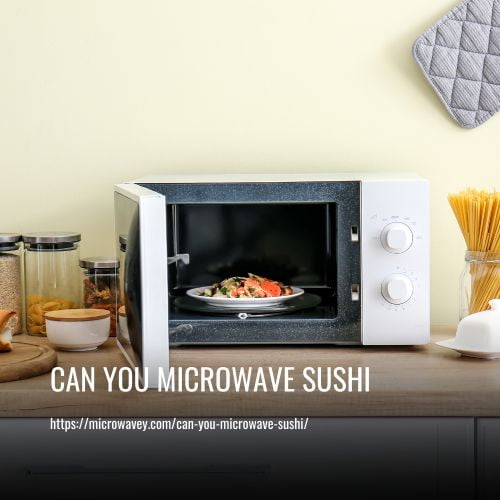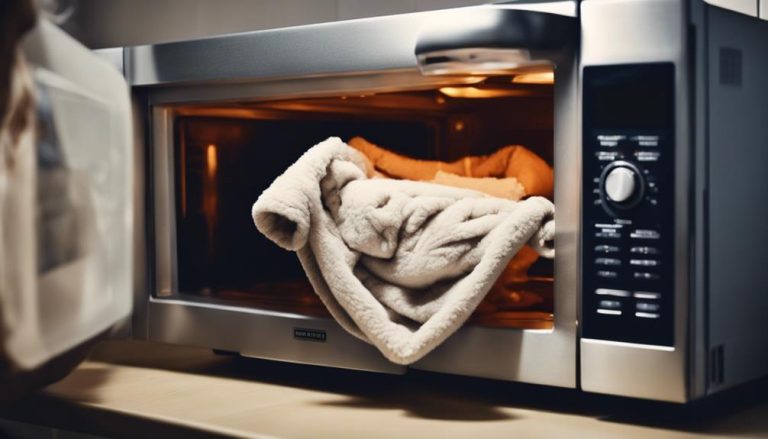Can You Microwave Sushi?
Yes, you can microwave sushi, but it’s recommended to eat sushi fresh to preserve its taste and texture. However, if you have leftover sushi that you want to warm up, cover it with a damp paper towel to trap steam and moisture and prevent it from drying out. Microwave the sushi in 10s intervals on medium heat, for up to three bursts.

How To Cook Microwave Sushi
Cooking sushi in the microwave may seem unconventional, but it can be a quick and convenient way to enjoy this delicious Japanese delicacy. In just 5 simple steps, you can have homemade microwave sushi that is ready to satisfy your sushi cravings.
With the right ingredients and proper techniques, you can create a flavorful and satisfying dish, all from the convenience of your microwave. Let’s explore the step-by-step process of cooking easy microwave sushi.
1. Cook The Rice
To begin preparing your microwave sushi, start by cooking the rice. Making rice in the microwave is quick and easy with these steps:
- Measure 1 cup of rice and add it to a microwave-safe dish. Add 2 cups of cold water.
- Microwave the rice on high for 10 minutes. If steam holes have appeared and most of the water has disappeared, move on to the next step. If not, continue microwaving in 1-minute increments until steam holes appear.
- Cover the dish with a microwave-safe lid or plastic wrap and microwave for 4 more minutes.
- Remove the rice from the microwave and let it stand, covered, for 5 minutes. Taste the rice to check if it’s the desired texture. If not, microwave for additional 1-minute increments until done.
Once the rice is cooked, let it rest for a few minutes before using it for sushi rolls or other sushi recipes. This cooking method provides a quick and convenient way to cook sushi rice using your microwave. Enjoy your homemade sushi with freshly cooked rice!
2. Cook The Veggies
- Fill a large bowl with chopped vegetables such as asparagus, broccoli, mushrooms, onions, or carrots.
- Season the vegetables with salt, garlic powder, and a few shakes of soy sauce.
- Cover the bowl with another plate or bowl and microwave for four minutes.
- Check the tenderness of the veggies and continue microwaving with the lid on for a few more minutes for softer vegetables.
3. Assemble The Rest Of Your Ingredients
- Thinly slice crab sticks and gather other ingredients like cucumber, arugula, red onion, or cream cheese.
4. Assemble Your Sushi Roll
- Place a sheet of nori on a wooden roller.
- Layer sushi rice on top of the nori sheet.
5. Add Your Desired Fillings
- Add the cooked vegetables and other desired fillings onto the rice.
6. Roll and Enjoy
- Use the wooden roller to tightly roll the sushi, making sure to seal the edges.
- Slice the sushi roll into bite-sized pieces and serve.
Note: Microwaving sushi is not recommended for raw fish sushi. This method is best for sushi rolls with cooked or vegetable fillings. Adjust the cooking time and microwave power level as needed to achieve the desired result.
What Will Happen With Rice After Microwaving
Microwaving sushi rice can significantly impact its taste and texture. When rice is microwaved, it tends to become dry and hard, which can alter the overall quality of the sushi. The heat from the microwave can cause the moisture in the rice to evaporate, resulting in a less desirable texture.
To improve the moisture level of microwaved rice, you can try a simple trick. Take a paper towel and soak it in soy sauce. Place the soaked paper towel over the rice before microwaving it. The moisture from the soy sauce will be absorbed by the rice, helping to restore some of its moisture content and prevent it from becoming too dry.
By using the paper towel soaked in soy sauce technique, you can maintain moisture and enhance the flavor of the rice. The soy sauce adds a subtle umami flavor to the rice, complementing the other ingredients of the sushi.
The Vegetable Will Never Taste the Same as a Fresh One
Reheated vegetables in sushi will never taste the same as fresh ones for several reasons. Heat has a significant impact on both the texture and flavor of vegetables, often causing them to lose their original qualities.
When vegetables are reheated, their texture tends to change. Crisp and crunchy vegetables, such as cucumber or radish, can become soft and lose their satisfying bite. The heat breaks down the cell walls, resulting in a softer texture that lacks the desired crunchiness.
Not only does reheating affect the texture, but it also alters the flavor of vegetables. Fresh vegetables in sushi provide a vibrant and distinct taste that can be compromised by reheating. The heat can diminish the natural flavors, making the vegetables taste more muted and less enjoyable.
Certain vegetables commonly found in sushi are particularly susceptible to the negative effects of reheating. For example, delicate greens like lettuce or spinach can quickly turn mushy and lose their crispiness when reheated. Similarly, vegetables with a high water content, like cucumber, tend to become limp and lose their refreshing taste when exposed to heat.
Will the Fish Regain Its Former Taste
It is important to note that the sushi fish will never regain its former taste after being microwaved. The delicate flavors and textures that are typically associated with fresh fish in sushi may be lost or altered when exposed to microwave heat.
If you prefer to warm up your sushi rather than using a microwave oven, another option is to pan-fry it. To do this, heat a small amount of oil in a skillet over medium heat. Place the sushi pieces in the skillet and cook on each side for about 30 seconds, or until lightly crisped.
This method can help retain some of the original flavors and provide a slightly different texture. For added flavor, you can also drizzle some sauces, such as soy sauce or spicy mayo, over the pan-fried sushi.
Is Reheating Sushi In The Microwave Safe
It is safe but, reheating sushi in the microwave is generally not recommended as it can affect the texture and taste of the sushi. The microwave can cause the rice to become dry and lose its moisture, resulting in a less enjoyable eating experience.
How Long Does It Take To Microwave The Sushi
To quickly reheat sushi in the microwave, place it in the microwave for about 30 seconds on a 500-watt power setting. Make sure to have a glass of water next to it to prevent dryness.
Sushi Reheating Tips In The Microwave
Reheating sushi in the microwave is not ideal, but it can be done. Here are some tips to ensure the best results:
- Place the leftover sushi rolls or individual pieces of sushi in a microwave-safe dish or plate.
- Add a small amount of cold water to the dish or plate to help retain moisture and prevent the sushi from drying out.
- Cover the dish or plate with a microwave-safe lid or wrap it with a damp paper towel to create a steamy environment.
- Set the microwave to medium power to gently heat the sushi without overheating or cooking it further.
- Start with a short heating time and then check the sushi for desired warmth. If it needs more time, continue heating in 10-second increments to avoid overcooking.
- Remember to be cautious when reheating raw fish sushi as it can become dry and lose its delicate texture. It’s best to focus on reheating sushi rolls or cooked sushi ingredients, like tempura or sweet potato, in the microwave.
- To maintain the quality and taste of sushi, it’s recommended to use fresh sushi within a day or two of its original preparation. Reheating sushi should be seen as a way to enjoy the leftovers, rather than attempting to recreate the taste of freshly made sushi.
- If you prefer a crispy texture, consider using a toaster oven or an alternative reheating method, such as baking or deep frying, for sushi that has been cooked or accompanied by deep-fried elements.
- Always exercise caution and ensure that the sushi is heated properly to prevent any potential foodborne illnesses.
What Are The Other Ways To Microwave-Free Methods To Heat Sushi
In addition to microwaving, there are other methods you can use to heat sushi without using a microwave. These methods can help you achieve a fresh taste while avoiding the potential risks of microwaving.
Whether you have leftover sushi or want to create a new dish using sushi ingredients, these microwave-free methods can provide alternative options for heating your sushi. Let’s explore some of these methods below.
1. Toaster Oven
Using a toaster oven is a great alternative to microwaving sushi. Preheat the toaster oven to a low temperature, around 300 degrees Fahrenheit, and place the sushi on a baking sheet. Heat the sushi for a few minutes, checking frequently, until it reaches the desired warmth.
This method is particularly effective for reheating sushi with delicate ingredients or fried rolls, as it helps to restore their crisp texture.
2. Steaming
Steaming is another microwave-free method that can be used to heat sushi. Fill a pot with a few inches of water and bring it to a boil. Place a heatproof dish on top of the pot and arrange the sushi on the dish in a single layer.
Cover the pot and steam the sushi for a couple of minutes until it is heated through. This gentle method helps retain moisture and prevents the sushi from drying out.
3. Sautéing
For a different twist, you can also sauté sushi ingredients to heat them up. Heat a small amount of oil in a pan over medium heat, and add the sushi ingredients.
Stir-fry them for a few minutes until they are heated and lightly browned. This method works best for sushi with ingredients like vegetables, tofu, or even cooked fish.
By utilizing these microwave-free methods, you can heat your sushi in alternative ways, preserving its original taste and texture. Experiment with these methods to find the one that suits your preference and enjoy a warm and satisfying sushi experience.
4. Deep-Fry
Deep-frying sushi is a unique and delicious method to reheat your sushi rolls. While it may not be the traditional way to enjoy sushi, deep-frying can provide a crispy and flavorful twist to this beloved dish. Here’s how you can deep-fry your sushi rolls as a reheating method:
- Prepare the sushi rolls: Start by removing any unsuitable ingredients from the sushi rolls such as avocado or raw fish. These ingredients may not hold up well during deep-frying. Stick to ingredients like cooked fish, vegetables, or even sweet potato for best results.
- Coat the sushi rolls: Roll the prepared sushi rolls in flour, ensuring that they are evenly coated. Then dip them into beaten eggs, making sure that the rolls are fully covered. Finally, coat the rolls with panko crumbs, pressing gently to adhere the crumbs to the rolls.
- Deep-fry the sushi rolls: Heat oil in a deep frying pan or pot to a temperature of about 350°F (175°C). Carefully place the coated sushi rolls into the hot oil and fry them for less than two minutes, or until they turn golden brown. Make sure to monitor your sushi rolls closely to avoid overcooking.
Deep-frying sushi rolls offers several benefits. Firstly, it amplifies the flavors and textures of the ingredients, creating a satisfying contrast between the crispy exterior and the soft interior. It helps to ensure that the sushi rolls hold their shape, preventing them from falling apart during reheating.
There are several methods you can use to reheat sushi, including pan-frying, baking, and deep-frying.
5. Pan-Fry
To pan-fry sushi, separate the rice from any fillings and discard any nori. Slice larger pieces into smaller pieces if desired. Heat oil in a wok and add the sushi. Cook on medium-high heat until the fish is browned and just cooked on the inside. Add your favorite sauce for extra flavor. This method is quick and can help reduce the risk of foodborne illness.
6. Bake
To bake sushi, preheat your oven to 325°F. Place the sushi on a baking sheet and heat for about eight minutes, or until the ingredients are warmed through. Flip the sushi halfway through to ensure even heating. This method may result in slightly crispy rice on the outside, which can be enjoyable.
Whichever method you choose, make sure to handle the sushi with care and monitor the cooking process closely to avoid overcooking. Enjoy your reheated sushi!
FAQs
Yes, you can microwave sushi, but it is important to do it correctly to avoid compromising its taste and quality. The key is to balance the heating time to ensure the sushi is warmed through without overcooking it.
To microwave sushi, place the sushi rolls or pieces on a microwave-safe plate or dish. If you have a platter of sushi, it’s advisable to separate it into individual pieces to promote even heating. Add a small amount of water to the dish or a glass of water next to the plate of sushi to provide moisture during the heating process.
Set the microwave to medium power or around 500-watt power to heat the sushi gently. Start with short heating intervals, such as 10-second increments, to prevent overheating. Check the sushi after each interval to determine if it has reached the desired temperature. The exact heating time may vary depending on the size and thickness of the sushi.
Yes, using a microwave-safe dish or container is essential when reheating sushi in the microwave. Ensure that the dish is suitable for microwave use to avoid any potential risks.
It is generally not recommended to microwave sushi with raw fish, as the prolonged heat can alter the taste and texture of the fish. However, you can still microwave sushi with cooked fillings or ingredients like vegetables or deep-fried items.
Microwaving sushi can result in softer and moister rice compared to the original sushi. The taste may also differ slightly, but it should still retain some of the original flavors. Keep in mind that microwaving should be a mild heating method to preserve the taste and texture as much as possible.
One option is to use a toaster oven, preheat the toaster oven to a low to medium temperature and place the sushi on a baking sheet or a heatproof dish. Heat the sushi for a few minutes until it reaches the desired temperature.
Another option is to wrap the sushi in aluminum foil and heat it in a conventional oven at a low temperature. This method helps retain the moisture and prevents the sushi from drying out.
You can also try using a steamer. Arrange the sushi pieces in a steamer basket and steam them over boiling water for a few minutes until they are warmed through.
Whichever method you choose, be mindful not to overheat the sushi as it can affect the taste and texture.
Yes, you can eat leftover sushi the next day. Leftover sushi should be refrigerated within two hours of being served. It is recommended to store it in an airtight container to prevent it from drying out. When reheating, you can use a toaster oven to gently warm it up.
Microwaving sushi can lead to unpleasant results, both in terms of taste and texture. The heat from the microwave can cause the sushi rice to become dry and hard, while also potentially making the seaweed wrapper soggy. Additionally, any raw fish in the sushi can become overcooked and lose its delicate flavor.
The recommended ratio of water to rice is 1:1. This means that for every cup of sushi rice, you should add one cup of water. Place the rice in a microwave-safe dish, add the water, and cover it with a microwave-safe lid or plastic wrap.
Microwave the rice on medium power for about 1-2 minutes per cup of rice. Check the rice after each minute and stir it to ensure even heating. The rice is done when it becomes soft and warm.
Wrap Up
In conclusion, reheating sushi in the microwave is a quick and convenient way to enjoy your favorite rolls at home. By following a few simple steps, you can easily bring back the authentic taste of freshly made sushi. It is important to properly reheat and freeze sushi to ensure its quality and safety.
Properly reheating sushi helps to maintain its soft and moist rice, as well as the taste of the fish. The microwave allows for a mild heating process, preserving the delicate flavors of the sushi ingredients. Additionally, when reheating sushi, it is crucial to use a microwave-safe dish to avoid any potential transfer of harmful substances.
Freezing sushi is another option for those who want to enjoy leftover sushi for a later time. By using an airtight container or freezer-safe bag, you can store your sushi rolls to preserve their freshness. When ready to eat, simply thaw the sushi in the refrigerator and then reheat it in the microwave using the recommended heating time and power settings.
Whether you have leftover sushi from a sushi party or simply want to enjoy the convenience of reheating sushi at home, the microwave is a reliable and effective reheating method. So go ahead and indulge in a plate of sushi, knowing that with the microwave, you can enjoy the authentic taste of this beloved dish anytime, anywhere.






